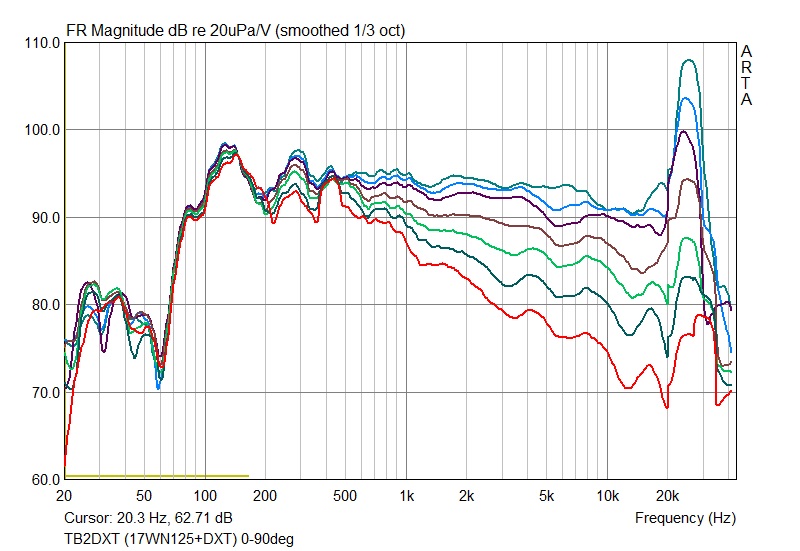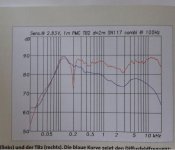As you've posted my measurements of my clone, I'd like to add measurements of an genuine TB2S (made by german magazine "production partner")
The driver PMC was using is excatly the same as I used - Vifa M17WG09-08 (german type designation: 17WN125).
The bass response of the PMC TB2S looks like an aperiodic cabinet. The response of your clone looks more like a bass reflex box.
Any insight on the reason of the difference?
The bass response of the PMC TB2S looks like an aperiodic cabinet. The response of your clone looks more like a bass reflex box.
Any insight on the reason of the difference?
I don't see the difference - there are some room modes in Burnett's measurement. You can't say if it's aperiodic vs TL vs BR without seeing the impedance sweep. Given how much stuffing is in Burnett's I would say it is most likely closer aperiodic TL.
@Burnett: thanks for responding and giving us more details. Do you like how it sounds with the dense stuffing or looser with more bass?
That means the equivalent wavelength of the internal acoustic tunnel is at the half wavelength of the woofer resonance. That's how the original Bradley transmission line speaker was designed.
No, TL is 1/4 wave, you misunderstood Bailey and Bradbury.You can deny all the wonderful test and analysis that Bailey and Bradbury did. But their mathematics convinced me that a transmission line has to be 1/2 wave line to work the way they claimed and measured.
PMC is using underdamped TL design - two peaks in the impedance measurements, and dip in the frequency response somewhere in the 150 to 200 Hz range, see Stereophile measurements:Would you agree that there is something very wrong with the response of these speakers, or am I expecting too much from them?
PMC DB1i loudspeaker Measurements | Stereophile.com
PMC IB-1S loudspeaker Measurements | Stereophile.com
Definitely not my cup of tea.
See Stereophile measurements above, PMC DB1i and PMC IB-1S have twin impedance peaks. All good TL designs have only one impedance peak, or the first peak is very small.The Martin King design is a variant of the bass reflex as shown by its twin peaks impedance curve.
The measurement of the impedance is a very good indication of this. A single peak near the woofer free resonant frequency Fs indicates a successful transmission line design or an aperiodic one. A twin peaks impedance indicates a bass reflex cabinet.
Can you provide a link to the web page that shows the impedance curves of your statement below?
No, it looks like underdamped TL, vith very high resonant peak in the high-bass rangeThe bass response of the PMC TB2S looks like an aperiodic cabinet.
Last edited:
Links to above stereophile articles don't seem to work. A sealed TL like Nautilus is half wave. Or my Nautaloss or Dagger sealed are 1/2-wave. Properly damped they flatten the impedance peak and there is only one on sealed TL.
Links work for me… i posted the impedance curves from there in post#25.
Sonce is correct, it is an underamped TL. Keilu would call is a BR, it isn't as shown by the underdamped harmonic the impedance curve shows at 200 Hz.
dave
Sonce is correct, it is an underamped TL. Keilu would call is a BR, it isn't as shown by the underdamped harmonic the impedance curve shows at 200 Hz.
dave
I don't see the difference - there are some room modes in Burnett's measurement. You can't say if it's aperiodic vs TL vs BR without seeing the impedance sweep. Given how much stuffing is in Burnett's I would say it is most likely closer aperiodic TL.
@Burnett: thanks for responding and giving us more details. Do you like how it sounds with the dense stuffing or looser with more bass?
With the additional room gain it sounds quite good - tight bass and reasonably low.
My dad is enjoying them for some time now.
Regarding the stuffing I only used a tiny bit more than PMC.
I think I can post an impedance measurement tomorrow.
Yes, sealed TL is 1/2 wave. I was referring to a more common ported TL (described by Bailey), which is 1/4 wave.A sealed TL like Nautilus is half wave. Or my Nautaloss or Dagger sealed are 1/2-wave.
Last edited:
I disagree with this statement by Sonce: All good TL designs have only one impedance peak, or the first peak is very small. Particularly the "good" part. I get so darned tired of people who make negative comments about there being twin impedance peaks signifying a TL design not being good or "proper" or a "true" TL. I know I've said it at least once in this thread, but if there is only one impedance peak or the lower-frequency peak is really, really small, all that has been created is a different version of a sealed box in terms of performance. If someone goes to the trouble of building a long, folded line, for instance, then stuffs the life out of it to achieve a sealed box rolloff, they're penalizing the bass performance since there's no or little contribution to it from the terminus output, and it won't sound any better (assuming we're just talking about bass) than if the box were simpler and sealed. The biggest laugh I get out of this thread is the fact that the PMC speakers, with their "ATL" designs and a very prominent pair of impedance peaks, are lauded for being so good and "like" a Bailey line.
Paul

Paul
Links work for me… i posted the impedance curves from there in post#25.
Sonce is correct, it is an underamped TL. Keilu would call is a BR, it isn't as shown by the underdamped harmonic the impedance curve shows at 200 Hz.
dave
No, TL is 1/4 wave, you misunderstood Bailey and Bradbury.
Bailey did not say "half wave" directly.
ARBailey said:The bass improvement was due to the line length being such that the delayed bass wave from the line was in phase with that radiated by the front of the cone.
The quote is from the Bailey 1965 article, page 2, column 2, line 14. I hope you understand what Bailey meant "in phase". I hope that you agree "in phase" means half wavelength.
Bradbury did not use the term "half wave" either, but said it more directly.
LJSBradbury said:However, at low frequencies bass lift is supposed to be achieved by producing sound from the open end of the labyrinth that is in phase with the sound radiating from the loudspeaker directly. This effect should occur when the wavelength of the sound in the pipe is in the region of twice the pipe length.
Bradbury article, page 167, column 2, line 2.
I hope that you would agree that the reciprocal of "twice the pipe length" means half wavelength.
Both Bailey and Bradbury showed solidly conducted test to support their claim of how transmission line works.
I don't think I misunderstood them. Show me the quotes that says otherwise or quarter wave. Yes, there are some reinforcement effect at 1/4, 3/4 wavelength etc., but they are 90 degrees out of phase. It is very basic physics.
Case closed. I will not reply to 1/4 wave question any further.
Last edited:
I disagree with this statement by Sonce: All good TL designs have only one impedance peak, or the first peak is very small. Particularly the "good" part. I get so darned tired of people who make negative comments about th
+1.
We have built some very good TLs that are ML-TLs.
The problem arises from the fact that MJK's models greatly expended TL space and some are still stuck in a midset where only a Bailey-style TL is a TL.
dave
I hope that you would agree that the reciprocal of "twice the pipe length" means half wavelength.
It does not. One has to account for the change from line to free-air at the terminus. Bailey's line is 1/4 wave.
TLs work & they are quarter wave.
dave
I've built at least 10 TLs for personal use and modeled many, many more for others, including ML-TL, ML-TQWT and tapered. All of them had twin impedance peaks and very good predicted performances. The ones I built for me sounded very good, too.
Paul
Paul
+1.
We have built some very good TLs that are ML-TLs.
The problem arises from the fact that MJK's models greatly expended TL space and some are still stuck in a midset where only a Bailey-style TL is a TL.
dave
All of them had twin impedance peaks and very good predicted performances.
I have done some with single peaks, but usually for mid-tweeters or for drivers that really would prefer to be OB.
dave
Well, all good vented speaker designs have twin impedance peaks. 😉 They can sound good, but all good sealed speaker designs (with only one impedance peak) are even better. The same goes for underdamped TL or ML-TL designs (with twin impedance peaks) vs optimally damped TL designs. Actually, I do not consider Bailey design optimal.I disagree with this statement by Sonce: All good TL designs have only one impedance peak, or the first peak is very small. Particularly the "good" part. I get so darned tired of people who make negative comments about there being twin impedance peaks signifying a TL design not being good or "proper" or a "true" TL. I know I've said it at least once in this thread, but if there is only one impedance peak or the lower-frequency peak is really, really small, all that has been created is a different version of a sealed box in terms of performance. If someone goes to the trouble of building a long, folded line, for instance, then stuffs the life out of it to achieve a sealed box rolloff, they're penalizing the bass performance since there's no or little contribution to it from the terminus output, and it won't sound any better (assuming we're just talking about bass) than if the box were simpler and sealed. The biggest laugh I get out of this thread is the fact that the PMC speakers, with their "ATL" designs and a very prominent pair of impedance peaks, are lauded for being so good and "like" a Bailey line.
Paul
I have listened to PMC DB1 and I don't like it at all - sorry. It has a typical sound of an underdamped TL, so much praised by some.
Bradbury did not use the term "half wave" either, but said it more directly.
Originally Posted by LJSBradbury
However, at low frequencies bass lift is supposed to be achieved by producing sound from the open end of the labyrinth that is in phase with the sound radiating from the loudspeaker directly. This effect should occur when the wavelength of the sound in the pipe is in the region of twice the pipe length.
Bradbury article, page 167, column 2, line 2.
I hope that you would agree that the reciprocal of "twice the pipe length" means half wavelength.
It does not. One has to account for the change from line to free-air at the terminus. Bailey's line is 1/4 wave.
TLs work & they are quarter wave.
dave
Ok. Dave, your math says one divided by two equals one quarter?
Bailey and Bradbury must both be wrong when they said the sound added when they are "in phase". TL works when they are 90 degrees out of phase? 😕
Don't get all wrapped up in degrees of phase - just look at the fluid mechanical boundary conditions. A closed end and the "no-slip" boundary condition says that velocity has to go to zero, hence it anchors one end of a 1/4-wave.
open end boundary conditions = 1/2 wave (e.g., flute), closed end - open end boundary conditions = 1/4 wave (e.g., clarinet) open end:
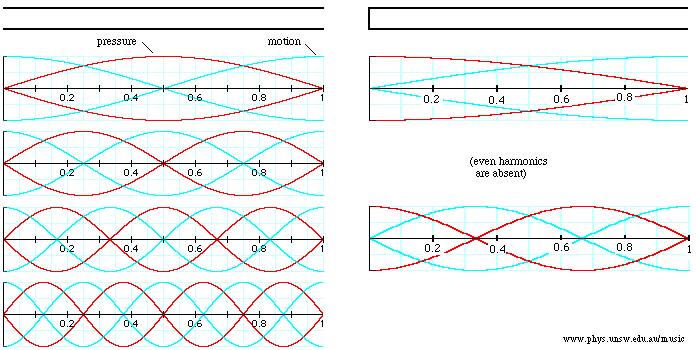
That is why a clarinet can play a note twice as low as an equivalent length flute.
A closed-closed pipe also has the same boundary conditions as an open-open TL, the sound just stays inside.
open end boundary conditions = 1/2 wave (e.g., flute), closed end - open end boundary conditions = 1/4 wave (e.g., clarinet) open end:

That is why a clarinet can play a note twice as low as an equivalent length flute.
A closed-closed pipe also has the same boundary conditions as an open-open TL, the sound just stays inside.
You said this in Post 50: I will not reply to 1/4 wave question any further.
Apparently you changed your mind. 😕
Paul
Apparently you changed your mind. 😕
Paul
Ok. Dave, your math says one divided by two equals one quarter?[/I]
Bailey and Bradbury must both be wrong when they said the sound added when they are "in phase". TL works when they are 90 degrees out of phase? 😕
You said this in Post 50: I will not reply to 1/4 wave question any further.
Apparently you changed your mind. 😕
Paul
Yes, I did.
Being a technical type person, I would never have expected that someone would say "the wavelength of the sound in the pipe is in the region of twice the pipe length" equals "1/4 wave".
I cannot stop chuckle and got sucker into replying. In reality, it is more a linguistic question than a "1/4 wave" question. 😉
On second thought, there may be some truth to that statement. In summary, what Beiley and Bradbury said was that they could make a physically 1/4 wave tube into a 1/2 wave tube by stuffing it with 1/2 lb/cuft of long fiber wool. They had analysis and test to prove that. They also showed that fiber glass or polyester fiber would have very different acoustic response.
There are many articles on the Bailey TL DIY projects in the "Speaker Builder" magazine in the 1970's. I built a pair myself and the plots below are the measurements I made almost 40 years ago. Building and listening to these speakers convinced me that Bailey was right.
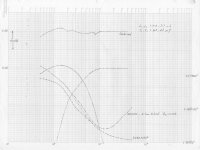
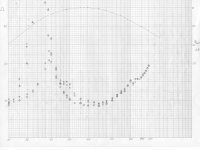
Sorry about the poor quality pictures. The plots were done by hand on graph paper. It was long before the PC time.
Last edited:
TBH, I've always thought transmission lines are the boringest speaker around. I listened to those old IMF TDL80's years ago and hated them.
They just BOOMED in a real room IMO. 😀

Whether you are talking about 1/4 or 1/2 wave lines, well you gotta ask relative to WHAT frequency? AFAIK, the frequency should be the Fs of the driver on an open infinite baffle.

Seems to me that BlindMelon7 is just asking how fat a sock he should stick at the output of the line. None of you monkeys seem to have an answer. 😛
They just BOOMED in a real room IMO. 😀

Whether you are talking about 1/4 or 1/2 wave lines, well you gotta ask relative to WHAT frequency? AFAIK, the frequency should be the Fs of the driver on an open infinite baffle.

Seems to me that BlindMelon7 is just asking how fat a sock he should stick at the output of the line. None of you monkeys seem to have an answer. 😛
- Status
- Not open for further replies.
- Home
- Loudspeakers
- Multi-Way
- PMC TL Stuffing
